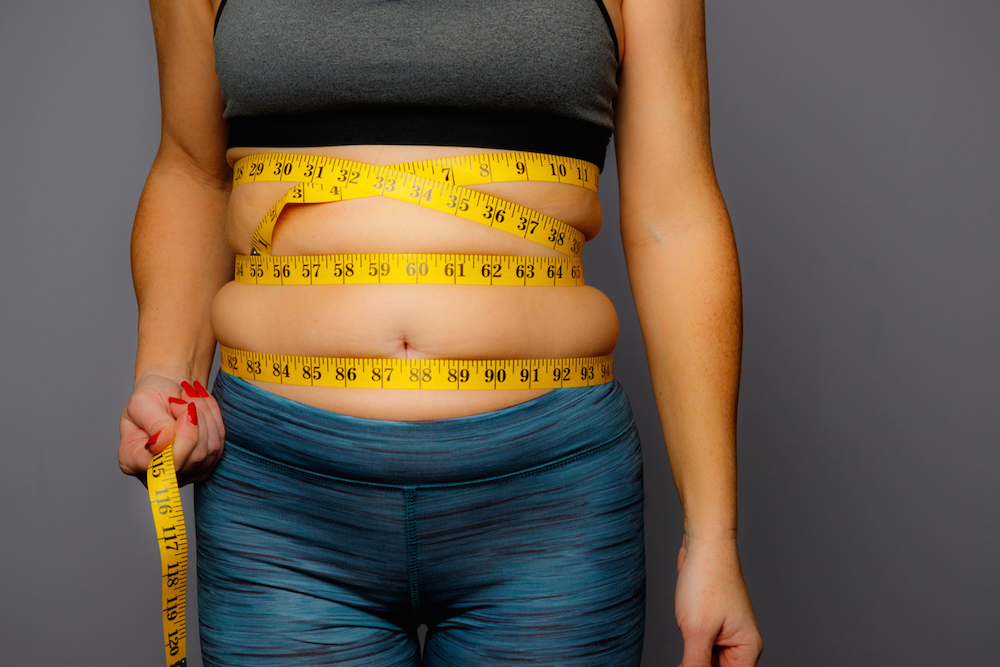Trying hard to lose belly fat but can’t? Trainer Terry Fairclough explains how hormones and an hormonal imbalance could be the reason for stubborn fat around the middle
You’re doing everything right – eating less sugar, exercising frequently and saying no to wine o’clock.
Yet, although most of your body is shaping up thanks to your efforts, the same can’t be said for that pesky belly fat.
The thing is, everybody tends to store fat in different places. Think bingo wings, man boobs, love handles, hips and thighs, these are all areas that body fat is stored, and this is down to gender, genetics and hormones.
everybody tends to store fat in different places
Many people tend to blame fat storing on the fact that you are getting older, the weather or bloating – but what most people don’t realise is that it could be down to your hormones and hormonal imbalance.
This can be said especially when it comes to belly fat.
Fat stored around the abdomen is known as belly fat, central fat, apple shape or fat around the middle. The bad news is, this type of fat is the most worrying known as visceral fat that surrounds our vital organs.
Many studies performed on hundreds of thousands of people have shown that abdominal or belly fat increases the risk of heart disease, cancer, hypertension and diabetes.
In fact, a study of over one 150,000 women showed that a normal weight woman who stored their fat around the middle had comparable risk of death than an obese woman. They also tend to have low muscle mass which is a further contributory factor for weight gain.
Conversely fat stored around the hips doesn’t release its fatty acids so readily into the blood stream like abdominal fat which is thought to be another risk factor for heart disease.
So, what causes abdominal fat?
The biggest culprit for storing fat around the middle is stress, this is due to the effect that stress has on our bodies.
When we are frightened or stressed our sympathetic nervous system gets excited and prepares our body for flight or fight.
To do this our body releases the hormone cortisol, which then releases stored fuel into our bloodstream in the form of fatty acids, sugars and amino acids to prepare for physical activity – fight or flight.
Sympathetic nerve endings in the adrenal glands release adrenaline while the sympathetic nerve endings throughout the body release noradrenaline.
The biggest culprit for storing fat around the middle is stress
Adrenaline and noradrenaline are chemical messengers that are released very quickly and start a cascade of physiological reactions in various organs such as an increased heart rate, down regulation of digestion, insulin resistance, mobilisation of fats, proteins and sugars into the bloodstream.
Trouble is, we usually don’t play out this physical response as we aren’t running away from threat or a fearful situation. Instead we are sat at our desk being worried about a deadline, and so this stress response goes unused.
All these sugars, fats and amino acids circulating in the blood stream due to your stressful situation or deadline are not needed while you are sitting at your desk, so they build up and can cause damage.
To protect itself from the damaging sugars, our bodies turn those excess calories into fat. Cells in the abdomen have more receptors for cortisol than any other part of the body, so most of that fat gets stored around the tummy area.
People who produce excess cortisol tend to have bulky waistlines and apple-shaped bodies rather than pear-shaped ones.
The pancreas also plays a part during stress response and releases the hormone glucagon which acts on the liver to release stored glucose (glycogen), this is to mobilise energy and ready the body for fight or flight.
In a panic to all this unwanted damaging fuel in the blood, insulin is secreted from the beta cells in the pancreas. Insulin then mops up and stores the fats, amino acids and sugars and pushes them into our cells.
This decisive over-reaction will cause more fats and sugars to be stored as fat.
Exactly why stress is making us fat
#1 Stress causes your metabolism to slow down
Cortisol breaks down biologically active protein into its simple form, amino acids from muscle found in different forms throughout the body.
This causes metabolism to slow, with less muscle, fewer calories are needed to power them, the excess calories are inevitably stored as fat. Our bodies only really care that we reproduce and stay alive.
Our fat stores are our high calorie life support. When this fat is chronically broken down, from the effects of cortisol the body panics by regulating fat receptors around fat cells (especially around the belly) to mitigate the loss.
Our bodies only really care that we reproduce and stay alive
This is why it is essential to eat enough calories, as under-eating over a long period will directly create the above reaction.
Plus, to compound things further under-eating will put the body in a stressed state increasing the release of cortisol.
#2 Stress also slows down thyroid function
A state of continual ‘constant alert’ signals the need to conserve energy for potential action. As a survival response to this perceived danger, the adrenal glands tell the thyroid gland to go-slow by down-regulating its output.
As the thyroid governs metabolism (the rate at which every body cell burns fuel or calories), lowered function means that weight loss becomes harder and harder.
See, cortisol also blocks the conversion of the thyroid hormone thyroxine 4 to the more potent hormone thyroxine 3.
The lower levels of thyroxine 3, the slower the metabolism, the greater weight gain.
Even if you measure ‘normal’ on a medical thyroid test, this gland can still be sub-optimally functioning. That is, it’s functioning just slow enough not to be hypothyroidism, but to affect metabolic rate.
#3 Stress raises the fat-attracting hormone oestrogen
Reproductive hormones such as testosterone, oestrogen and progesterone are also effected when we are stressed, as are human growth hormone and insulin which affect chances of pregnancy.
Men seem more susceptible than woman to gaining belly fat. Oestrogen is a hormone that drives fat storage around the hips and thighs.
When women reach pre-menopause (in their 40s-50s), their ovaries stop producing female hormones, including oestrogen. Post-menopause, woman convert androgen (a corticotropin male hormone secreted from the adrenals) into oestrogen.
low levels of oestrogen cause fat to accumulate around the middle
The low levels of oestrogen cause fat to accumulate around the middle. Oestrogen is also produced from fat cells.
Studies show that woman of normal healthy weight with higher levels of stress and negative mood are more likely to increase visceral fat around the organs.
#4 Stress stops you from sleeping
Lack of good quality sleep will also increase cortisol, as will underrating due to stress which again can affect sleep.
If our blood sugar drops in the night adrenaline is realised to help bring blood sugar back to proper levels as this is what helps to wake us up.
Poor sleep will have a massive knock on effect on liver detoxification, immunity, exercise and work productivity.
#5 Stress causes you to make unhealthy choices
Cortisol increases appetite, this is because we are breaking down stores, so we need to take in more food to fuel and replenish stores.
However, when you are stressed you are less likely to reach for healthier options. Instead we rely on alcohol to reduce our stress or we reach for sugar to give us a boost in energy.
We also tend to avoid exercise and some even adopt bad habits such as smoking, which in turn will contribute to weight gain and belly fat.
Performing the wrong type of exercise routine may not necessarily cause fat to be stored around the middle but it wont help in reducing it. It is essential to train right for your body type.
How can we manage stress to reduce belly fat?
#1 Exercise right for your body type
Stress, unhealthy lifestyle, poor diet, lack of sleep are not exclusive to an individual body type. We recommend all body types (endomorph, mesomorph, ectomorph) try the below recommendations as this will help de-stress, reduce cortisol and lose belly fat.
As a quick rule, an exercise routine for an ectomorph should consist predominately of two to three full body resistance workouts, keeping the weights heavy with one steady state cardio, working at just below lactic threshold for 20-30 minutes per week.
A mesomorph should also perform full body workouts, splitting the resistance and cardio 50/50, however their cardio sessions should be high intensity hit training of around 30 seconds high intensity 45 seconds low intensity.
The endomorph body types exercise routine should be higher in high intensity cardio, around 20 seconds on high intensity phase 45 seconds low intensity phase. This body type should do one full body resistance workout per week.
#2 Try something new that works for you
Yoga, meditation, art classes, exhibitions, naps, reading, massages, therapy – whatever tends to reduce your stress levels, set some time apart each day to make sure you are making an effort to actively reduce your stress levels.
Hugs, sex and love will also help to lower cortisol levels thanks to the feel good hormone oxytocin.
#3 Increase your magnesium intake
Stress uses up a lot of magnesium, this mineral also aids the parasympathetic nervous system subsequently helping relaxation and sleep.
Eat foods high in magnesium such as green leafy vegetables, nuts, brown rice, meat and fish. Dark chocolate is thought to reduce cortisol.
Plus, magnesium will also help you get better quality sleep which is also key in reducing stress levels.
#4 Increase your B and D vitamins too
B1, B5 support the adrenal glands (which work hard in times of stress), and aid energy metabolism. Foods high in vitamin B include, eggs, liver, legumes, milk, green leafy vegetables, salmon.
Increase Vitamin D by exposure to the sun for 20 minutes a day and increasing foods high in vitamin D such as tuna, salmon, sardines, egg yolks and liver.
#5 Don’t under-eat
Eat enough food for your body type, height, weight, activity level and goal, but not too much.
Have a look at our body type calculator to find out how many calories a day you should be eating, and the correct macronutrient (fat, carbohydrates and protein) you need.
Terry Fairclough is one of the Your Body Programme’s founders, as well as a Personal Trainer and Nutritional Therapist.
When he is not busy writing notes on the back of his hand (rather than into Google Docs), then he likes to pump iron.
Terry is an ectomorph who trains hard for his big guns.
Relevant healthista content
Healthy eating – What this Instagram fitness legend eats in a day
9 healthy diet myths making you fat
11 healthiest alcoholic drinks – a nutritionist’s guide
More healthista content
17 best lubes to make your sex life better
3 easy vegan soup recipes to warm you up this winter
7 easy hair growth tips for long, luscious locks
Tired all the time? You might have sleep apnoea – here’s a doctor’s guide on what to do
Like this article? Sign up to our newsletter to get more articles like this delivered straight to your inbox.




























































